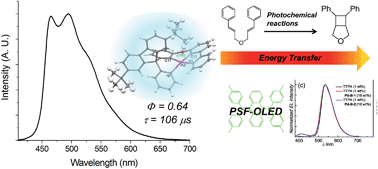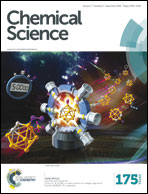Highly luminescent palladium(ii) complexes with sub-millisecond blue to green phosphorescent excited states. Photocatalysis and highly efficient PSF-OLEDs†
Abstract
Palladium(II) complexes supported by tetradentate [N^C^C^N] and [O^N^C^N] ligand systems display sky blue to red phosphorescence with emission quantum yields and emission lifetimes up to 0.64 and 272 μs, respectively. Femtosecond time-resolved fluorescence (fs-TRF) measurements on these Pd(II) complexes reveal a fast intersystem crossing from singlet to triplet manifolds with time constants of 0.6–21 ps. DFT/TDDFT calculations revealed that, as a result of the spiro-fluorene and bridging tertiary amine units of the ligands, the T1 excited state is more ligand-localized and has smaller structural distortion, leading to slower non-radiative decay as well as radiative decay of T1 → S0 transition and thereby highly emissive, long-lived triplet excited states. The Pd(II) complexes have been found to be efficient catalysts for visible light-driven, reductive C–C bond formation from unactivated alkyl bromides with conversions and yields of up to 90% and 83%, respectively. These complexes have also been employed as photosensitizers for [2 + 2] cycloaddition of styrenes, with conversions and yields comparable to those of the reported Ir(III) complexes. Both green and sky blue organic-light emitting devices (OLEDs) have been generated with these Pd(II) complexes as guest emitters. Maximum external quantum efficiencies (EQE) of up to 16.5% have been achieved in the sky blue OLEDs. The long emission lifetimes render the Pd(II) complexes good sensitizers for phosphor-sensitized fluorescent OLEDs (PSF-OLEDs). By utilizing these phosphorescent Pd(II) complexes as sensitizers, highly efficient green and yellow PSF-OLEDs having high EQE (up to 14.3%), high colour purity and long operation lifetimes, with 90% of initial luminance (LT90) for more than 80 000 h, have been realized.


 Please wait while we load your content...
Please wait while we load your content...